10+ literary analysis practice worksheets + activities for your ELA class
by mindroar | Oct 10, 2022 | blog | 0 comments
Now, our previous post was about how to teach your students to do a literary analysis or critical analysis. By now, you might be wondering if you can easily find a literary analysis practice worksheet to help your ELA students learn critical analysis skills.
I figured that a follow-up post of worksheets and activities that you can quickly and easily use would be in order.
So if you are teaching your students literary analysis skills and you need a little help, check out these great literary analysis activities and worksheets to use in your ELA classroom.

1. Nouvelle ELA – quote analysis
The first resource we have for you today is this PowerPoint and analyzing quotes activity by Nouvelle ELA.
The aim of the resources is to help your students learn to analyze and embed quotes in their writing.
In this fun literary analysis lesson, students analyze movie quotes and then have scaffolded help to practice embedding those quotes into their writing. Students practice the skills of:
- Identifying who said the quote
- Summarizing the context of the quote, and
- Analyzing why the quote matters
Included in the activity are
- an editable PowerPoint that introduces how to analyze quotes
- an Interactive notebook lesson
- literary quote analysis homework worksheet that is print and go
- and an editable literary quote analysis homework sheet
2. A moonlighting English teacher – prose analysis and close reading
The second literary analysis practice worksheet we have today is this prose analysis and close reading bundle by A moonlighting English teacher.
The bundle includes activities to help students understand over 55 high-level literary terms, as well as practice and improve their skills in close reading and critical analysis.
While most of the resources were designed with specific texts in mind, most are able to stand alone as individual lessons or resources and are easily adaptable to whatever texts you are using in your class.
Included in the bundle are:
- a list of every literary term and definition covered in each activity in the bundle
- AP Literature prose analysis essay materials, including prose analysis passages and activities from The Poisonwood Bible , The Things They Carried , The Good Earth , Nectar in a Sieve , and Remembering
- an AP Literature prose analysis essay activity that helps students break down two official sample essays
- AP Literature prose essay materials, including advice and model outlines, a self-assessment, an a general rubric
- seven creative activities to analyze literary devices in any novel or story, which is also distance-learning compatible
- an activity to scaffold improving prose analysis commentary using Nectar in a Sieve
- an activity on diction and motifs using The Good Earth
- two quote analysis activities using The Good Earth
- a nonfiction analysis and a rhetorical analysis handout
- an activity on humor using The Poisonwood Bible
- an activity on specific syntax devices using The Poisonwood Bible and an activity on the usage of low diction using The Things They Carried
- a general AP Literature prose analysis essay practice/outline worksheet
- creative activities on tone using The Poisonwood Bible and irony using Cry, the Beloved Country
- and a self-created prose essay assignment
3. Reading the rapids – identifying literary elements
Other great literary analysis lessons include these ones by Reading the rapids. This fun bundle will help your students identify literary elements.
Students learn and reinforce their learning by watching animated shorts, using graphic organizers, applying their learning in activities, and assessing their peers. Literary elements students learn about include:
- direct and indirect characterization
- types of conflict (man vs self/man/society/technology/nature/supernatural)
- what is and is not an inference
- types of irony
- juxtaposition
- mood and tone
- personification
The bundle covers many different CCSS and each lesson plan states which skills are covered in that lesson.
The author also has this great free literary device inventory and reflection to help you work out your students’ level of knowledge about literary devices. It also uses animated shorts so that the activity is fun and engaging for students to complete.
3. Tracee Orman – showing evidence from the text
The next literary analysis practice worksheet is included in this activity by Tracee Orman. In the activities, students will learn how to adequately show evidence from the text.
In the activity, students use three non-fiction texts and questions to practice citing evidence from the text. Suggested answers for each question are included, as well as the evidence students should use.
The passages include interesting scenarios including
- a woman and her son are sprayed with poop from a plane flying overhead
- a woman takes in two kittens only to find out they’re bobcats
- a federal court rules on whether a monkey (or other animal/non-human) can sue for copyright infringement.
The files are provided as non-editable PDFs or a Google slides version of the worksheet for students to respond to digitally.
4. Reading and writing haven – analyzing different text types
The next literary analysis practice worksheet we have for you is this bundle by Reading and writing haven. The bundle enables students to practice analyzing a variety of texts, including non-fiction, fiction, paired texts, short films, movies, advertisements, and poetry.
The materials and the scaffolding guiding questions and prompts enable students to better understand how to analyze texts. Included in the bundle are
- a direct instruction presentation and guided notes that breaks down the concept of analyzing
- a whole-class analyzing activity that uses a poem, a short film, and two political cartoons (suggested use is included)
- an assignment that contains scaffolded questions to use with any text
- a short film analysis assignment (of Night and Day ) with scaffolded questions and an extended response (film available on YouTube)
- seven graphic organizers to use with a variety of texts (commercials, songs, fiction, nonfiction, poems, movies, and paired texts – text suggestions/recommendations with links are included)
- a pre- and post-assessment
- a literary analysis essay example to help move students from analyzing verbally to analyzing in a literary analysis format
- an editable single-point rubric and outline with guiding questions to accompany the literary analysis essay
- a unit overview (recommendations for order and text ideas)
- suggested texts and links to sources to use for whole-class modeling purposes
5. Secondary Sara – finding evidence from the text
Another way to get your students to practice literary analysis when studying any novel is by using this fun activity by Secondary Sara.
The Common Core-aligned activity is set up as a “conspiracy theory” that students have to “prove”. To do so, students practice finding and using evidence to back up a claim.
In the activity, student groups choose a question about the novel and come up with a “conspiracy theory” (thesis) to answer that question.
While reading, small groups gather text evidence from the novel and analyze it using a four-step method: What does it SAY?, What does it MEAN?, Why does it MATTER?, How does it prove your THESIS?
Once they have completed the novel and graphic organizer, students give presentations on their thesis and the evidence they collected to support it.
The rest of the class actively listens by following along with their own listening guide to track who said what.
You can also use an optional follow-up essay assignment to individually assess literary analysis skills.
Included in the download are:
- a rubric that clearly assesses speaking standards
- teacher guide that provides essential questions, I Can statements, CCSS standards for grades 6-8, a sample calendar of lessons, and tips for successful implementation of the group project.
- directions sheet and rubric
- thesis statement development/approval sheet
- case file planning sheet (chart to collect and analyze text evidence while reading)
- listening guide for presentations
- sample PowerPoint template to give students so they know how to format and organize all of their evidence (and it helps them transition into an essay later)
- literary analysis essay assignment (directions and rubric)
- Google, Word, and PDF versions
- bonus pages: a nonfiction activity to research what conspiracy theories are, evaluating evidence in a theory mini-lesson, and analyzing the quality of an essay’s claims mini-lesson
7. Write on with Miss G – low-risk literary analysis practice
Another fun literary analysis practice worksheet is included in this speed-dating lesson by Write on with Miss G. The discussion and literary analysis activities work with any novel.
In the activity, students are paired up to discuss questions aligned with the Common Core standards. After each round, students rotate to a new partner and discuss a new question.
By the end of class, students will have interacted with 15+ peers and discussed 15+ questions! This means students get lots of low-risk, repeated practice in the peer-to-peer setting.
This literary analysis practice activity enables your entire class to participate in literary analysis in a low-risk setting and set students up for success in whole-class discussions (that you can do following the speed-dating lesson).
This activity works best at the end of a novel, as it contains questions that ask about “the big picture” (theme, symbolism, etc.)
- detailed teacher instructions
- editable student worksheet with an exit ticket
- 27 editable Common Core-aligned question cards
- blank question cards (so you can add your own questions)
Literary elements covered in the questions include
- author’s choices
- author’s purpose
- character development
- word choice
- point of view
- objective summary
- and structure
8. Tracee Orman – interactive flipbook
Another literary analysis practice worksheet is included in this interactive notebook flipbook for any novel by Tracee Orman.
You can choose to use the literary analysis activity as an interactive flipbook, or you can choose to use them as literary analysis practice worksheets.
The activities cover six main areas. These areas are
- character development: students must analyze how the setting, events, and other characters have influenced each other
- setting: students analyze how the setting affects the tone of the story and how different themes utilize the setting to convey their messages
- point-of-view: students evaluate either first-person, third-person limited, or third-person omniscient narration–depending on the novel or story–and how different events, the setting, and other characters impact the way it is narrated; students also analyze why the author chose that perspective and how it influences different themes
- plot analysis: students choose different events from the novel and analyze how each contributes to the tension and conflict in the story; students also evaluate the author’s structure of the story and why/how the author uses various literary techniques for storytelling
- literary and figurative devices: students examine the words used in various quotes and how they change or impact the tone and mood of the story; students also identify and explain various figurative language devices such as simile, metaphor, personification, hyperbole, idiom, and imagery
- overall effects: students dissect a theme to see which characters, events, and elements of the setting helped deepen its meaning of it.
Using these literary analysis practice worksheets or interactive notebooks, students practice higher-level critical-thinking skills which include analysis, synthesis, inference, summarizing, and more.
The activities can be used at any point in the text and can be reused at any point, making them even more versatile. They are perfect for stations, group work, or individual independent reading.
9. Teen tech university – analyzing author’s tone
The next literary analysis practice worksheet is included in this activity by Teen tech university, which focuses on teaching students how to analyze the author’s tone in writing.
Included in the product are
- an analyzing tone Google Slides presentation (30+ slides)
- DIDLS charts for strategic tone analysis – they show students how to analyze diction, imagery, details, language, and syntax
- four poems to analyze – they are all on the same subject but have a different tone
- teacher’s key for ALL poems and activities
- tone tweets activity – students analyze 15 real-life tweets with a student handout and a teacher answer key
- engaging reading passages for practice and application
- an assessable application activity – a high school graduation where two teens with very different viewpoints
- a writing application activity – My greatest fear
- tone words reference sheet (positive, neutral, and negative connotation)
- annotation activities for active reading and examples
- teacher notes and pacing guide
- Google Drive sharing links for all resources AND pdf handouts provided for printing options.
10. Celebrating Secondary – literary analysis of short films
Another fun way to get your students to practice literary analysis is to use short films to introduce, practice, or review the process. This bundle by Celebrating secondary enables students to practice literary analysis in a low-risk setting by analyzing short films.
Included in the bundle are two products: Literary analysis using Pixar short films and Literary analysis using short films. Literary topics and skills covered by the activities include:
- characterization
- connotation
- social commentary
- author’s purpose
- and many more
The product includes links to Pixar shorts, including Bao, Lou, Lifted, Partly Cloudy, and La Luna . It also includes links to short films, including Lambs, Nuggets, Snack Attack, Soar, and The Little Shoemaker .
A suggested answer key is included, but because the activities are analysis-based answers will vary.
11. Miss Fits – “recipe” of a text analysis
The last literary analysis practice worksheet is included in this recipe book project by Miss Fits.
In the CCSS-aligned project, students show their understanding and interpretation of the main ideas and themes of a literary work in a fun and creative way. They will practice citing textual evidence to support their examination of a literary work, including themes and characterization.
This activity works fantastically with books that have a large emphasis on food, such as
Lara Esquivel’s Like Water for Chocolate , Eat, Pray, Love by Elizabeth Gilbert, Sweetbitter by Stephanie Danler, or The Joy Luck Club by Amy Tan.
However, it can also be used with other texts, with the creator saying she’s used it with a class reading George Orwell’s 1984 and another student using it as an alternative project for The Handmaid’s Tale.
Included in the product are:
- an assignment sheet explaining the objective and instructions for the project
- rubric (editable version also included)
- an imagery tracker
- a creative symbolism exercise
- step-by-step recipe worksheet to help students create their projects, and
- sample entries
Want more literary analysis content?
Check out these blog posts
- Literary analysis: how to teach your ELA students to analyze
- 5 research-backed reasons you should be teaching mind mapping
Want a literary analysis example to show your ELA students? Sign up to have an example literary analysis of Jane Austen’s Emma delivered to your inbox.
beginner's guide to literary analysis
Understanding literature & how to write literary analysis.
Literary analysis is the foundation of every college and high school English class. Once you can comprehend written work and respond to it, the next step is to learn how to think critically and complexly about a work of literature in order to analyze its elements and establish ideas about its meaning.
If that sounds daunting, it shouldn’t. Literary analysis is really just a way of thinking creatively about what you read. The practice takes you beyond the storyline and into the motives behind it.
While an author might have had a specific intention when they wrote their book, there’s still no right or wrong way to analyze a literary text—just your way. You can use literary theories, which act as “lenses” through which you can view a text. Or you can use your own creativity and critical thinking to identify a literary device or pattern in a text and weave that insight into your own argument about the text’s underlying meaning.
Now, if that sounds fun, it should , because it is. Here, we’ll lay the groundwork for performing literary analysis, including when writing analytical essays, to help you read books like a critic.
What Is Literary Analysis?
As the name suggests, literary analysis is an analysis of a work, whether that’s a novel, play, short story, or poem. Any analysis requires breaking the content into its component parts and then examining how those parts operate independently and as a whole. In literary analysis, those parts can be different devices and elements—such as plot, setting, themes, symbols, etcetera—as well as elements of style, like point of view or tone.
When performing analysis, you consider some of these different elements of the text and then form an argument for why the author chose to use them. You can do so while reading and during class discussion, but it’s particularly important when writing essays.
Literary analysis is notably distinct from summary. When you write a summary , you efficiently describe the work’s main ideas or plot points in order to establish an overview of the work. While you might use elements of summary when writing analysis, you should do so minimally. You can reference a plot line to make a point, but it should be done so quickly so you can focus on why that plot line matters . In summary (see what we did there?), a summary focuses on the “ what ” of a text, while analysis turns attention to the “ how ” and “ why .”
While literary analysis can be broad, covering themes across an entire work, it can also be very specific, and sometimes the best analysis is just that. Literary critics have written thousands of words about the meaning of an author’s single word choice; while you might not want to be quite that particular, there’s a lot to be said for digging deep in literary analysis, rather than wide.
Although you’re forming your own argument about the work, it’s not your opinion . You should avoid passing judgment on the piece and instead objectively consider what the author intended, how they went about executing it, and whether or not they were successful in doing so. Literary criticism is similar to literary analysis, but it is different in that it does pass judgement on the work. Criticism can also consider literature more broadly, without focusing on a singular work.
Once you understand what constitutes (and doesn’t constitute) literary analysis, it’s easy to identify it. Here are some examples of literary analysis and its oft-confused counterparts:
Summary: In “The Fall of the House of Usher,” the narrator visits his friend Roderick Usher and witnesses his sister escape a horrible fate.
Opinion: In “The Fall of the House of Usher,” Poe uses his great Gothic writing to establish a sense of spookiness that is enjoyable to read.
Literary Analysis: “Throughout ‘The Fall of the House of Usher,’ Poe foreshadows the fate of Madeline by creating a sense of claustrophobia for the reader through symbols, such as in the narrator’s inability to leave and the labyrinthine nature of the house.
In summary, literary analysis is:
- Breaking a work into its components
- Identifying what those components are and how they work in the text
- Developing an understanding of how they work together to achieve a goal
- Not an opinion, but subjective
- Not a summary, though summary can be used in passing
- Best when it deeply, rather than broadly, analyzes a literary element
Literary Analysis and Other Works
As discussed above, literary analysis is often performed upon a single work—but it doesn’t have to be. It can also be performed across works to consider the interplay of two or more texts. Regardless of whether or not the works were written about the same thing, or even within the same time period, they can have an influence on one another or a connection that’s worth exploring. And reading two or more texts side by side can help you to develop insights through comparison and contrast.
For example, Paradise Lost is an epic poem written in the 17th century, based largely on biblical narratives written some 700 years before and which later influenced 19th century poet John Keats. The interplay of works can be obvious, as here, or entirely the inspiration of the analyst. As an example of the latter, you could compare and contrast the writing styles of Ralph Waldo Emerson and Edgar Allan Poe who, while contemporaries in terms of time, were vastly different in their content.
Additionally, literary analysis can be performed between a work and its context. Authors are often speaking to the larger context of their times, be that social, political, religious, economic, or artistic. A valid and interesting form is to compare the author’s context to the work, which is done by identifying and analyzing elements that are used to make an argument about the writer’s time or experience.
For example, you could write an essay about how Hemingway’s struggles with mental health and paranoia influenced his later work, or how his involvement in the Spanish Civil War influenced his early work. One approach focuses more on his personal experience, while the other turns to the context of his times—both are valid.
Why Does Literary Analysis Matter?
Sometimes an author wrote a work of literature strictly for entertainment’s sake, but more often than not, they meant something more. Whether that was a missive on world peace, commentary about femininity, or an allusion to their experience as an only child, the author probably wrote their work for a reason, and understanding that reason—or the many reasons—can actually make reading a lot more meaningful.
Performing literary analysis as a form of study unquestionably makes you a better reader. It’s also likely that it will improve other skills, too, like critical thinking, creativity, debate, and reasoning.
At its grandest and most idealistic, literary analysis even has the ability to make the world a better place. By reading and analyzing works of literature, you are able to more fully comprehend the perspectives of others. Cumulatively, you’ll broaden your own perspectives and contribute more effectively to the things that matter to you.
Literary Terms to Know for Literary Analysis
There are hundreds of literary devices you could consider during your literary analysis, but there are some key tools most writers utilize to achieve their purpose—and therefore you need to know in order to understand that purpose. These common devices include:
- Characters: The people (or entities) who play roles in the work. The protagonist is the main character in the work.
- Conflict: The conflict is the driving force behind the plot, the event that causes action in the narrative, usually on the part of the protagonist
- Context : The broader circumstances surrounding the work political and social climate in which it was written or the experience of the author. It can also refer to internal context, and the details presented by the narrator
- Diction : The word choice used by the narrator or characters
- Genre: A category of literature characterized by agreed upon similarities in the works, such as subject matter and tone
- Imagery : The descriptive or figurative language used to paint a picture in the reader’s mind so they can picture the story’s plot, characters, and setting
- Metaphor: A figure of speech that uses comparison between two unlike objects for dramatic or poetic effect
- Narrator: The person who tells the story. Sometimes they are a character within the story, but sometimes they are omniscient and removed from the plot.
- Plot : The storyline of the work
- Point of view: The perspective taken by the narrator, which skews the perspective of the reader
- Setting : The time and place in which the story takes place. This can include elements like the time period, weather, time of year or day, and social or economic conditions
- Symbol : An object, person, or place that represents an abstract idea that is greater than its literal meaning
- Syntax : The structure of a sentence, either narration or dialogue, and the tone it implies
- Theme : A recurring subject or message within the work, often commentary on larger societal or cultural ideas
- Tone : The feeling, attitude, or mood the text presents
How to Perform Literary Analysis
Step 1: read the text thoroughly.
Literary analysis begins with the literature itself, which means performing a close reading of the text. As you read, you should focus on the work. That means putting away distractions (sorry, smartphone) and dedicating a period of time to the task at hand.
It’s also important that you don’t skim or speed read. While those are helpful skills, they don’t apply to literary analysis—or at least not this stage.
Step 2: Take Notes as You Read
As you read the work, take notes about different literary elements and devices that stand out to you. Whether you highlight or underline in text, use sticky note tabs to mark pages and passages, or handwrite your thoughts in a notebook, you should capture your thoughts and the parts of the text to which they correspond. This—the act of noticing things about a literary work—is literary analysis.
Step 3: Notice Patterns
As you read the work, you’ll begin to notice patterns in the way the author deploys language, themes, and symbols to build their plot and characters. As you read and these patterns take shape, begin to consider what they could mean and how they might fit together.
As you identify these patterns, as well as other elements that catch your interest, be sure to record them in your notes or text. Some examples include:
- Circle or underline words or terms that you notice the author uses frequently, whether those are nouns (like “eyes” or “road”) or adjectives (like “yellow” or “lush”).
- Highlight phrases that give you the same kind of feeling. For example, if the narrator describes an “overcast sky,” a “dreary morning,” and a “dark, quiet room,” the words aren’t the same, but the feeling they impart and setting they develop are similar.
- Underline quotes or prose that define a character’s personality or their role in the text.
- Use sticky tabs to color code different elements of the text, such as specific settings or a shift in the point of view.
By noting these patterns, comprehensive symbols, metaphors, and ideas will begin to come into focus.
Step 4: Consider the Work as a Whole, and Ask Questions
This is a step that you can do either as you read, or after you finish the text. The point is to begin to identify the aspects of the work that most interest you, and you could therefore analyze in writing or discussion.
Questions you could ask yourself include:
- What aspects of the text do I not understand?
- What parts of the narrative or writing struck me most?
- What patterns did I notice?
- What did the author accomplish really well?
- What did I find lacking?
- Did I notice any contradictions or anything that felt out of place?
- What was the purpose of the minor characters?
- What tone did the author choose, and why?
The answers to these and more questions will lead you to your arguments about the text.
Step 5: Return to Your Notes and the Text for Evidence
As you identify the argument you want to make (especially if you’re preparing for an essay), return to your notes to see if you already have supporting evidence for your argument. That’s why it’s so important to take notes or mark passages as you read—you’ll thank yourself later!
If you’re preparing to write an essay, you’ll use these passages and ideas to bolster your argument—aka, your thesis. There will likely be multiple different passages you can use to strengthen multiple different aspects of your argument. Just be sure to cite the text correctly!
If you’re preparing for class, your notes will also be invaluable. When your teacher or professor leads the conversation in the direction of your ideas or arguments, you’ll be able to not only proffer that idea but back it up with textual evidence. That’s an A+ in class participation.
Step 6: Connect These Ideas Across the Narrative
Whether you’re in class or writing an essay, literary analysis isn’t complete until you’ve considered the way these ideas interact and contribute to the work as a whole. You can find and present evidence, but you still have to explain how those elements work together and make up your argument.
How to Write a Literary Analysis Essay
When conducting literary analysis while reading a text or discussing it in class, you can pivot easily from one argument to another (or even switch sides if a classmate or teacher makes a compelling enough argument).
But when writing literary analysis, your objective is to propose a specific, arguable thesis and convincingly defend it. In order to do so, you need to fortify your argument with evidence from the text (and perhaps secondary sources) and an authoritative tone.
A successful literary analysis essay depends equally on a thoughtful thesis, supportive analysis, and presenting these elements masterfully. We’ll review how to accomplish these objectives below.
Step 1: Read the Text. Maybe Read It Again.
Constructing an astute analytical essay requires a thorough knowledge of the text. As you read, be sure to note any passages, quotes, or ideas that stand out. These could serve as the future foundation of your thesis statement. Noting these sections now will help you when you need to gather evidence.
The more familiar you become with the text, the better (and easier!) your essay will be. Familiarity with the text allows you to speak (or in this case, write) to it confidently. If you only skim the book, your lack of rich understanding will be evident in your essay. Alternatively, if you read the text closely—especially if you read it more than once, or at least carefully revisit important passages—your own writing will be filled with insight that goes beyond a basic understanding of the storyline.
Step 2: Brainstorm Potential Topics
Because you took detailed notes while reading the text, you should have a list of potential topics at the ready. Take time to review your notes, highlighting any ideas or questions you had that feel interesting. You should also return to the text and look for any passages that stand out to you.
When considering potential topics, you should prioritize ideas that you find interesting. It won’t only make the whole process of writing an essay more fun, your enthusiasm for the topic will probably improve the quality of your argument, and maybe even your writing. Just like it’s obvious when a topic interests you in a conversation, it’s obvious when a topic interests the writer of an essay (and even more obvious when it doesn’t).
Your topic ideas should also be specific, unique, and arguable. A good way to think of topics is that they’re the answer to fairly specific questions. As you begin to brainstorm, first think of questions you have about the text. Questions might focus on the plot, such as: Why did the author choose to deviate from the projected storyline? Or why did a character’s role in the narrative shift? Questions might also consider the use of a literary device, such as: Why does the narrator frequently repeat a phrase or comment on a symbol? Or why did the author choose to switch points of view each chapter?
Once you have a thesis question , you can begin brainstorming answers—aka, potential thesis statements . At this point, your answers can be fairly broad. Once you land on a question-statement combination that feels right, you’ll then look for evidence in the text that supports your answer (and helps you define and narrow your thesis statement).
For example, after reading “ The Fall of the House of Usher ,” you might be wondering, Why are Roderick and Madeline twins?, Or even: Why does their relationship feel so creepy?” Maybe you noticed (and noted) that the narrator was surprised to find out they were twins, or perhaps you found that the narrator’s tone tended to shift and become more anxious when discussing the interactions of the twins.
Once you come up with your thesis question, you can identify a broad answer, which will become the basis for your thesis statement. In response to the questions above, your answer might be, “Poe emphasizes the close relationship of Roderick and Madeline to foreshadow that their deaths will be close, too.”
Step 3: Gather Evidence
Once you have your topic (or you’ve narrowed it down to two or three), return to the text (yes, again) to see what evidence you can find to support it. If you’re thinking of writing about the relationship between Roderick and Madeline in “The Fall of the House of Usher,” look for instances where they engaged in the text.
This is when your knowledge of literary devices comes in clutch. Carefully study the language around each event in the text that might be relevant to your topic. How does Poe’s diction or syntax change during the interactions of the siblings? How does the setting reflect or contribute to their relationship? What imagery or symbols appear when Roderick and Madeline are together?
By finding and studying evidence within the text, you’ll strengthen your topic argument—or, just as valuably, discount the topics that aren’t strong enough for analysis.

Step 4: Consider Secondary Sources
In addition to returning to the literary work you’re studying for evidence, you can also consider secondary sources that reference or speak to the work. These can be articles from journals you find on JSTOR, books that consider the work or its context, or articles your teacher shared in class.
While you can use these secondary sources to further support your idea, you should not overuse them. Make sure your topic remains entirely differentiated from that presented in the source.
Step 5: Write a Working Thesis Statement
Once you’ve gathered evidence and narrowed down your topic, you’re ready to refine that topic into a thesis statement. As you continue to outline and write your paper, this thesis statement will likely change slightly, but this initial draft will serve as the foundation of your essay. It’s like your north star: Everything you write in your essay is leading you back to your thesis.
Writing a great thesis statement requires some real finesse. A successful thesis statement is:
- Debatable : You shouldn’t simply summarize or make an obvious statement about the work. Instead, your thesis statement should take a stand on an issue or make a claim that is open to argument. You’ll spend your essay debating—and proving—your argument.
- Demonstrable : You need to be able to prove, through evidence, that your thesis statement is true. That means you have to have passages from the text and correlative analysis ready to convince the reader that you’re right.
- Specific : In most cases, successfully addressing a theme that encompasses a work in its entirety would require a book-length essay. Instead, identify a thesis statement that addresses specific elements of the work, such as a relationship between characters, a repeating symbol, a key setting, or even something really specific like the speaking style of a character.
Example: By depicting the relationship between Roderick and Madeline to be stifling and almost otherworldly in its closeness, Poe foreshadows both Madeline’s fate and Roderick’s inability to choose a different fate for himself.
Step 6: Write an Outline
You have your thesis, you have your evidence—but how do you put them together? A great thesis statement (and therefore a great essay) will have multiple arguments supporting it, presenting different kinds of evidence that all contribute to the singular, main idea presented in your thesis.
Review your evidence and identify these different arguments, then organize the evidence into categories based on the argument they support. These ideas and evidence will become the body paragraphs of your essay.
For example, if you were writing about Roderick and Madeline as in the example above, you would pull evidence from the text, such as the narrator’s realization of their relationship as twins; examples where the narrator’s tone of voice shifts when discussing their relationship; imagery, like the sounds Roderick hears as Madeline tries to escape; and Poe’s tendency to use doubles and twins in his other writings to create the same spooky effect. All of these are separate strains of the same argument, and can be clearly organized into sections of an outline.
Step 7: Write Your Introduction
Your introduction serves a few very important purposes that essentially set the scene for the reader:
- Establish context. Sure, your reader has probably read the work. But you still want to remind them of the scene, characters, or elements you’ll be discussing.
- Present your thesis statement. Your thesis statement is the backbone of your analytical paper. You need to present it clearly at the outset so that the reader understands what every argument you make is aimed at.
- Offer a mini-outline. While you don’t want to show all your cards just yet, you do want to preview some of the evidence you’ll be using to support your thesis so that the reader has a roadmap of where they’re going.
Step 8: Write Your Body Paragraphs
Thanks to steps one through seven, you’ve already set yourself up for success. You have clearly outlined arguments and evidence to support them. Now it’s time to translate those into authoritative and confident prose.
When presenting each idea, begin with a topic sentence that encapsulates the argument you’re about to make (sort of like a mini-thesis statement). Then present your evidence and explanations of that evidence that contribute to that argument. Present enough material to prove your point, but don’t feel like you necessarily have to point out every single instance in the text where this element takes place. For example, if you’re highlighting a symbol that repeats throughout the narrative, choose two or three passages where it is used most effectively, rather than trying to squeeze in all ten times it appears.
While you should have clearly defined arguments, the essay should still move logically and fluidly from one argument to the next. Try to avoid choppy paragraphs that feel disjointed; every idea and argument should feel connected to the last, and, as a group, connected to your thesis. A great way to connect the ideas from one paragraph to the next is with transition words and phrases, such as:
- Furthermore
- In addition
- On the other hand
- Conversely

Step 9: Write Your Conclusion
Your conclusion is more than a summary of your essay's parts, but it’s also not a place to present brand new ideas not already discussed in your essay. Instead, your conclusion should return to your thesis (without repeating it verbatim) and point to why this all matters. If writing about the siblings in “The Fall of the House of Usher,” for example, you could point out that the utilization of twins and doubles is a common literary element of Poe’s work that contributes to the definitive eeriness of Gothic literature.
While you might speak to larger ideas in your conclusion, be wary of getting too macro. Your conclusion should still be supported by all of the ideas that preceded it.
Step 10: Revise, Revise, Revise
Of course you should proofread your literary analysis essay before you turn it in. But you should also edit the content to make sure every piece of evidence and every explanation directly supports your thesis as effectively and efficiently as possible.
Sometimes, this might mean actually adapting your thesis a bit to the rest of your essay. At other times, it means removing redundant examples or paraphrasing quotations. Make sure every sentence is valuable, and remove those that aren’t.
Other Resources for Literary Analysis
With these skills and suggestions, you’re well on your way to practicing and writing literary analysis. But if you don’t have a firm grasp on the concepts discussed above—such as literary devices or even the content of the text you’re analyzing—it will still feel difficult to produce insightful analysis.
If you’d like to sharpen the tools in your literature toolbox, there are plenty of other resources to help you do so:
- Check out our expansive library of Literary Devices . These could provide you with a deeper understanding of the basic devices discussed above or introduce you to new concepts sure to impress your professors ( anagnorisis , anyone?).
- This Academic Citation Resource Guide ensures you properly cite any work you reference in your analytical essay.
- Our English Homework Help Guide will point you to dozens of resources that can help you perform analysis, from critical reading strategies to poetry helpers.
- This Grammar Education Resource Guide will direct you to plenty of resources to refine your grammar and writing (definitely important for getting an A+ on that paper).
Of course, you should know the text inside and out before you begin writing your analysis. In order to develop a true understanding of the work, read through its corresponding SuperSummary study guide . Doing so will help you truly comprehend the plot, as well as provide some inspirational ideas for your analysis.
Trending Post : 12 Powerful Discussion Strategies to Engage Students
10 of the Best Literary Analysis Activities to Elevate Thinking
Inside this Post: Ready to elevate your literary analysis lessons? This post is full of engaging and effective activities to help students master literary analysis topics.
Literary analysis has become the beating heart of English classes around the world. When students read a text, we want them to peel back the layers one by one, appreciating the deeper meaning that lies within each sentence. As English teachers, many of us connect with texts easily and persevere through complex literature naturally. For our students, this process is not always as enjoyable.
In this post, you’ll find suggestions for elevating thinking with middle and high school students. These ideas can be used with paired or individual texts and can be differentiated to reach a variety of learners.
Engaging and Effective Literary Analysis Activities
Literary analysis elements are best when they are engaging and elevate thinking without frustrating students. I’ve played around with different approaches, and these are the key elements that resonate most with students.

1. Thinking Aloud
One of the best feelings as a teacher is knowing you have an entire class full of teenagers engaged. It’s amazing how every single student in a classroom is in tune with think alouds. Something about making thinking transparent challenges students of all readiness levels. With literary analysis lessons, I love providing think alouds with the whole class. Whether we do this via face to face instruction or by creating a short video for virtual classrooms, we have to model our thinking.
Here’s an example with “All the world’s a stage” from William Shakespeare’s As You Like It …
This speech, at first, seems complicated. But, Shakespeare is talking about the world being a stage, and I think there is something deeper to what he is saying. Let’s go back again and look for clues. The men and women are players on the stage. He writes that they have their exits and entrances. I’m trying to visualize that in my head now. The world is a stage, the people are actors, and when they walk on and off the stage, that is their theatrical entrance and exit. Now that I understand he is using this speech as an extended metaphor, I wonder why would Shakespeare is choosing to compare these two things?
When modeling literary analysis, we can break down our thought process. If we write a written response, we can scaffold by color coding our thoughts in order to highlight the necessary critical thinking steps.
- First, acknowledge what is confusing or uncertain about the text. What might we be missing as readers?
- Second, make observations.
- Third, apply reading strategies (in this case, I used visualizing).
- Last, teach students to ask questions that probe at the deeper meaning and reason for the writing.
2. Graphic Organizers
Graphic organizers are one of my go-to strategies for elevating thinking . We can use them to differentiate and to guide students as we work in small groups. I like to keep a variety of literary analysis graphic organizers for any text on hand so that I can be responsive. If students show a need to work on analyzing a specific literary element – characterization, plot, theme, conflict, etcetera – I use a graphic organizer as we read a text or excerpt together, modeling my thinking. Then, students can practice using the same organizer in small groups, partners, or independently.
Literary analysis consists of asking a bunch of questions to lead students to deeper thinking, and graphic organizers are a bridge that walks students down that path of purposeful questioning.
Grab this print and digital literary analysis graphic organizer for analyzing song lyrics – one of secondary students’ favorite texts to pick apart!
Nothing grabs a student’s attention like an image! Visuals are amazing tools for introducing literary analysis skills. I always begin my literary analysis unit with pictures. Using an image, we can quickly show students how to differentiate between summarizing and analyzing . Then, we can walk them through the steps of acknowledging what we might be missing, making observations, applying reading strategies, and questioning for deeper meaning.
Consider using images from a variety of sources. We can try historical images, political cartoons, famous paintings, graphic novels, wordless picture books, advertisements, or even just regular photographs.
I even work this type of analytical thinking into my vocabulary activities ! Students get used to interpreting photos and using textual evidence to support their thinking.
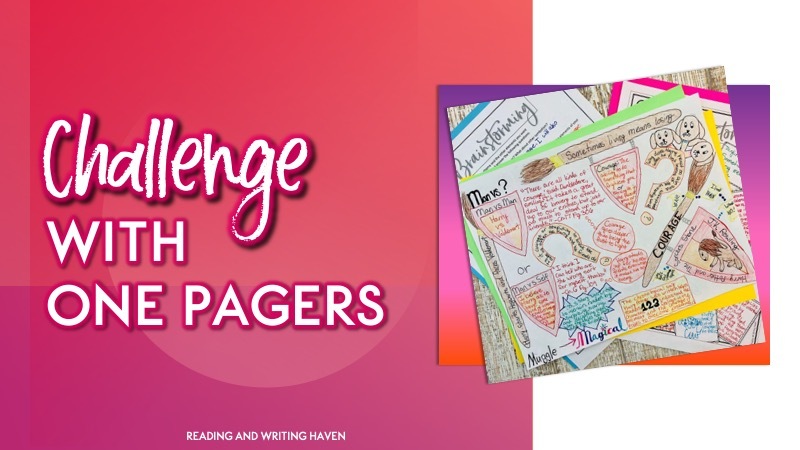
4. One Pagers
One pagers are one of my favorite literary analysis activities. In order to make them meaningful, I incorporate scaffolding . So, students have access to standards-aligned goals and questions that prompt their responses to the text. Choice helps as well. We can allow students to choose digital or traditional , response angles, and even texts.
In terms of literary analysis benefits, we can really focus on asking students to cite textual evidence to track a universal theme. While doing so, students can draw conclusions about how literary elements work together or how they provide tension to impact a reader’s overall takeaway.
5. Colorful Charts
Mood and tone can be tricky for students to analyze. So that they can understand the difference between them but also so that they see how mood and tone work in tandem, I began using an equalizer metaphor . Students can use color and amplification to analyze how mood and tone change throughout a literary work. By creating a visual representation, there’s a direct connection between the mood and the storyline.
How does setting impact mood , and how does mood impact the conflict in the story?
For instance, the quiet beauty of the Capulet garden sets the stage for a romantic balcony scene, but the noisy bustle of the lewd fighting in the Verona streets helps to define the conflict and tension between the two feuding families.
With tone , how does the author’s word choice and sentence structure in each section convey his or her attitude in the work?
As we study the amplification of tone in the play Romeo and Juliet , we see a consistent change from light-hearted comedy to an intensely poetic and tragic seriousness. Over the course of the play, one might say that Shakespeare’s juxtaposition creates an overall sympathetic tone toward the star-crossed lovers.

6. Get Moving
One of the issues when it comes to citing evidence in a literary analysis essay is finding relevant support. Sometimes, it seems like the lines students select from literature are completely disconnected from what they are writing. That may be because they don’t truly understand how their thesis connects to their main points or how their main points connect to the evidence. For some students, there are too many degrees of separation!
A kinesthetic option to address this issue involves Post-Its (or colored text boxes if you are doing this digitally) and a t-chart. At the top of the paper (use big paper or a white board if you can do this together in the classroom!), write the analytical point. What conclusion can students draw about characters, setting, or another literary element that would support their thesis statement?
Under that, label the T-Chart as “Relevant” and “Off Topic.” Then, you have some options.
BASIC: You identify support for students in advance and have them sort the support based on its relevance. Could they use it to analyze the text, or is it off topic?
ADVANCE: Ask students to find examples of relevant and off-topic lines from the text.
A MIXTURE: Provide students with a handful of lines they can sort into relevant and off-topic categories, and then ask them to find a couple more examples on their own.
To increase the engagement factor, use some washi tape on the floor in the shape of whatever makes the most sense – a character outline for analyzing character, a house for analyzing setting, a circle for analyzing a universal theme. Then, have students stick their Post-It notes inside or outside of the shape. Inside indicates that the evidence is relevant, and outside means it’s off-topic.
7. Children’s Books
We don’t always think to use picture books with older students , but they are one of my absolute favorite ways to scaffold literary analysis! Because picture books are short, we can cover an entire (and often complex) story in a short period of time. And, we can continually refer back to that text throughout the school year. Because picture books are accessible for all students, they will remember sharing the story together, and you can really make significant strides with whole-class discussions and small group lessons.
Try using picture books to teach Notice and Note signposts, language, aesthetics, and theme . One of my favorite ways to use picture books is teaching students to analyze how dialogue impacts decisions, propels action, and develops characters. For example, in the book Elbow Grease , the protagonist is motivated to participate in a race for which he is the underdog simply because some crass comments from his friends make him angry. This really is the turning point in the story, which makes it convenient to analyze how dialogue can lead to decisions and actions that change the course of a storyline.

8. Short Films
For a thousand and one reasons, I adore short films. They’re short (obvious, I know), which makes them ideal for modeling and mini lessons. Plus, they are visually captivating and apply to a wide age range. And, generally, they hold quite a bit of depth and leave room for a variety of interpretations.
During first quarter with ninth graders, I built in a yearly routine of watching short films during our literary analysis unit and having students complete their first full analytical essay. It’s fun. I can model using a short film I enjoy. Then, I get to read a wide range of responses from students who choose different texts. To scaffold for struggling writers, I suggest a few short films I am very familiar with; this way, I can guide them if they get stuck or confused.
You can also build in short films by using them with poetry for paired text analysis .
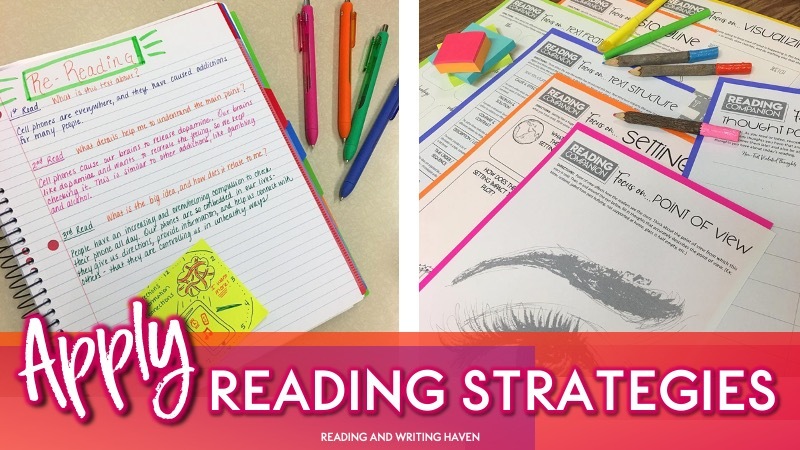
9. Reading Strategies
One of the building blocks of literary analysis is having a good foundation in apply reading strategies. It’s fun to model what readers do. We can show students how analyzing texts and re-reading for deeper meaning helps us with writing and then ask students to practice those skills.
For instance, when students begin to understand that authors have a purposeful craft that impacts their reading experience, it empowers them to pick that craft apart, studying the nuances of what makes it work. And, it gives them an advantage as authors themselves. They may think, I remember how the author’s purposeful use of short, staccato sentences and onomatopoeias increased the suspense during that scene. Maybe I should use those techniques in this part of my story to add an emotional element for my readers.
These are some of the graphic organizers I’ve used to scaffold reading strategy work with the whole class, and then students can transfer those skills to small group or independent practice, using the same organizer if necessary.
10. Social Media Activities
Social media is everywhere. We might as well use it as a relevant option for analyzing literature! One of my favorites is booksnaps , and I tie in Snapchat by having them take a photo of part of the text they want to analyze. Then, they add interpretations, images, and text as well as a caption with a more detailed analysis. I call these Snap-a-Books. I also created a Spot-a-Book analysis option, reminiscent of Spotify playlists. Students can create playlists relevant to character analysis, setting analysis, conflict analysis, and more!
And, that’s ten! I hope you’ve found some meaningful literary analysis activities to spark creative, critical thinking in your classroom.
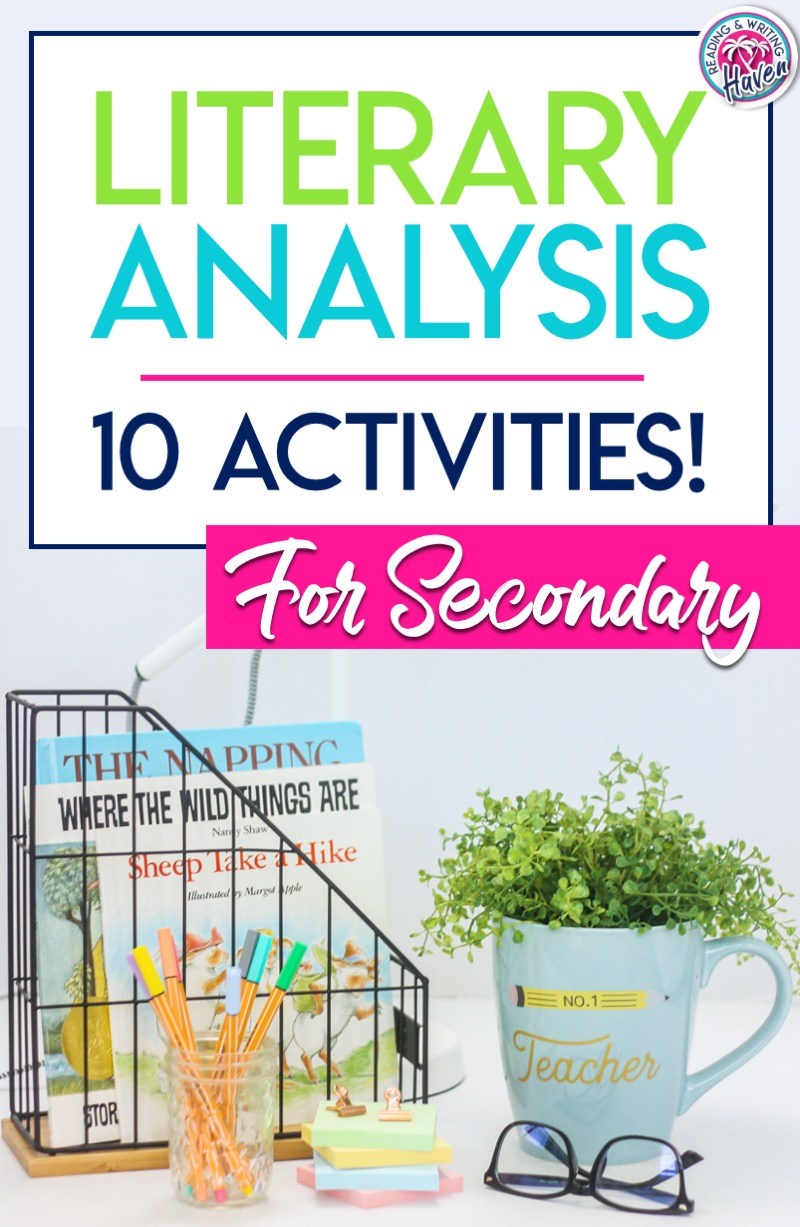
Get the latest in your inbox!
- Chess (Gr. 1-4)
- TV (Gr. 1-4)
- Metal Detectors (Gr. 2-6)
- Tetris (Gr. 2-6)
- Seat Belts (Gr. 2-6)
- The Coliseum (Gr. 2-6)
- The Pony Express (Gr. 2-6)
- Wintertime (Gr. 2-6)
- Reading (Gr. 3-7)
- Black Friday (Gr. 3-7)
- Hummingbirds (Gr. 3-7)
- Worst Game Ever? (Gr. 4-8)
- Carnivorous Plants (Gr. 4-8)
- Google (Gr. 4-8)
- Honey Badgers (Gr. 4-8)
- Hyperinflation (Gr. 4-8)
- Koko (Gr. 4-8)
- Mongooses (Gr. 5-9)
- Trampolines (Gr. 5-9)
- Garbage (Gr. 5-9)
- Maginot Line (Gr. 5-9)
- Asian Carp (Gr. 5-9)
- Tale of Two Countries (Gr. 6-10)
- Kevlar (Gr. 7-10)
- Tigers (Gr. 7-11)
- Statue of Liberty (Gr. 8-10)
- Submarines (Gr. 8-12)
- Castles (Gr. 9-13)
- Gutenberg (Gr. 9-13)
- Author's Purpose Practice 1
- Author's Purpose Practice 2
- Author's Purpose Practice 3
- Fact and Opinion Practice 1
- Fact and Opinion Practice 2
- Fact and Opinion Practice 3
- Idioms Practice Test 1
- Idioms Practice Test 2
- Figurative Language Practice 1
- Figurative Language Practice 2
- Figurative Language Practice 3
- Figurative Language Practice 4
- Figurative Language Practice 5
- Figurative Language Practice 6
- Figurative Language Practice 7
- Figurative Language Practice 8
- Figurative Language Practice 9
- Figurative Language of Edgar Allan Poe
- Figurative Language of O. Henry
- Figurative Language of Shakespeare
- Genre Practice 1
- Genre Practice 2
- Genre Practice 3
- Genre Practice 4
- Genre Practice 5
- Genre Practice 6
- Genre Practice 7
- Genre Practice 8
- Genre Practice 9
- Genre Practice 10
- Irony Practice 1
- Irony Practice 2
- Irony Practice 3
- Making Inferences Practice 1
- Making Inferences Practice 2
- Making Inferences Practice 3
- Making Inferences Practice 4
- Making Inferences Practice 5
- Main Idea Practice 1
- Main Idea Practice 2
- Point of View Practice 1
- Point of View Practice 2
- Text Structure Practice 1
- Text Structure Practice 2
- Text Structure Practice 3
- Text Structure Practice 4
- Text Structure Practice 5
- Story Structure Practice 1
- Story Structure Practice 2
- Story Structure Practice 3
- Author's Purpose
- Characterizations
- Context Clues
- Fact and Opinion
- Figurative Language
- Grammar and Language Arts
- Poetic Devices
- Point of View
- Predictions
- Reading Comprehension
- Story Structure
- Summarizing
- Text Structure
- Character Traits
- Common Core Aligned Unit Plans
- Teacher Point of View
- Teaching Theme
- Patterns of Organization
- Project Ideas
- Reading Activities
- How to Write Narrative Essays
- How to Write Persuasive Essays
- Narrative Essay Assignments
- Narrative Essay Topics
- Persuasive Essay Topics
- Research Paper Topics
- Rubrics for Writing Assignments
- Learn About Sentence Structure
- Grammar Worksheets
- Noun Worksheets
- Parts of Speech Worksheets
- Punctuation Worksheets
- Sentence Structure Worksheets
- Verbs and Gerunds
- Examples of Allitertion
- Examples of Hyperbole
- Examples of Onomatopoeia
- Examples of Metaphor
- Examples of Personification
- Examples of Simile
- Figurative Language Activities
- Figurative Language Examples
- Figurative Language Poems
- Figurative Language Worksheets
- Learn About Figurative Language
- Learn About Poetic Devices
- Idiom Worksheets
- Online Figurative Language Tests
- Onomatopoeia Worksheets
- Personification Worksheets
- Poetic Devices Activities
- Poetic Devices Worksheets
- About This Site
- Privacy Policy
- Terms of Use
- Understanding CCSS Standards
- What's New?
Ereading Worksheets
Free reading worksheets, activities, and lesson plans., site navigation.
- Learn About Author’s Purpose
- Author’s Purpose Quizzes
- Character Types Worksheets and Lessons
- List of Character Traits
- Differentiated Reading Instruction Worksheets and Activities
- Fact and Opinion Worksheets
- Irony Worksheets
- Animal Farm Worksheets
- Literary Conflicts Lesson and Review
- New Home Page Test
- Lord of the Flies Chapter 2 Worksheet
- Lord of the Flies Chapter 5 Worksheet
- Lord of the Flies Chapter 6 Worksheet
- Lord of the Flies Chapter 10 Worksheet
- Narrative of the Life of Frederick Douglass
- Sister Carrie
- The Count of Monte Cristo
- The Odyssey
- The War of the Worlds
- The Wizard of Oz
- Mood Worksheets
- Context Clues Worksheets
- Inferences Worksheets
- Main Idea Worksheets
- Making Predictions Worksheets
- Nonfiction Passages and Functional Texts
- Setting Worksheets
- Summarizing Worksheets and Activities
- Short Stories with Questions
- Story Structure Activities
- Story Structure Worksheets
- Tone Worksheets
- Types of Conflict Worksheets
- Reading Games
- Figurative Language Poems with Questions
- Hyperbole and Understatement Worksheets
- Simile and Metaphor Worksheets
- Simile Worksheets
- Hyperbole Examples
- Metaphor Examples
- Personification Examples
- Simile Examples
- Understatement Examples
- Idiom Worksheets and Tests
- Poetic Devices Worksheets & Activities
- Alliteration Examples
- Allusion Examples
- Onomatopoeia Examples
- Onomatopoeia Worksheets and Activities
- Genre Worksheets
- Genre Activities
- Capitalization Worksheets, Lessons, and Tests
- Contractions Worksheets and Activities
- Double Negative Worksheets
- Homophones & Word Choice Worksheets
- ‘Was’ or ‘Were’
- Simple Subjects & Predicates Worksheets
- Subjects, Predicates, and Objects
- Clauses and Phrases
- Type of Sentences Worksheets
- Sentence Structure Activities
- Comma Worksheets and Activities
- Semicolon Worksheets
- End Mark Worksheets
- Noun Worksheets, Lessons, and Tests
- Verb Worksheets and Activities
- Pronoun Worksheets, Lessons, and Tests
- Adverbs & Adjectives Worksheets, Lessons, & Tests
- Preposition Worksheets and Activities
- Conjunctions Worksheets and Activities
- Interjections Worksheets
- Parts of Speech Activities
- Verb Tense Activities
- Past Tense Worksheets
- Present Tense Worksheets
- Future Tense Worksheets
- Point of View Activities
- Point of View Worksheets
- Teaching Point of View
- Cause and Effect Example Paragraphs
- Chronological Order
- Compare and Contrast
- Order of Importance
- Problem and Solution
- Text Structure Worksheets
- Text Structure Activities
- Essay Writing Rubrics
- Narrative Essay Topics and Story Ideas
- Narrative Essay Worksheets & Writing Assignments
- Persuasive Essay and Speech Topics
Persuasive Essay Worksheets & Activities
- Writing Narrative Essays and Short Stories
- Writing Persuasive Essays
- All Reading Worksheets
- Understanding Common Core State Standards
- Remote Learning Resources for Covid-19 School Closures
- What’s New?
- Ereading Worksheets | Legacy Versions
- Online Figurative Language Practice
- Online Genre Practice Tests
- Online Point of View Practice Tests
- 62 School Project Ideas
- 2nd Grade Reading Worksheets
- 3rd Grade Reading Worksheets
- 4th Grade Reading Worksheets
- 5th Grade Reading Worksheets
- 6th Grade Reading Worksheets
- 7th Grade Reading Worksheets
- 8th Grade Reading Worksheets
- 9th Grade Reading Worksheets
- 10th Grade Reading Worksheets
- Membership Billing
- Membership Cancel
- Membership Checkout
- Membership Confirmation
- Membership Invoice
- Membership Levels
- Your Profile
Want Updates?
84 comments.
Thank you so much. This has truly helped me in my exams and throughout the beneficial journey of my school year.
Ellen Davis
How will I be able to check my work, when I print it out to work on them? Where are the answers?
I guess it depends on what you are working on. On what are you working?
Kareema Coles
Ummm the pdf version is not working…is the link still valid?
Which link?
This is an amazing website with fabulous ideas and printable ready to go lessons!!! Thank you so much! I wish I could meet you!!!
Thank you very much for this amazing resource and great ideas. They are extremely comprehensive and well designed. Thank you very much for your kind consideration and not adding a Price-tag to your valuable resources. Highly appreciated.
Sandra Conner
Thank you so much for sharing your knowledge and your work with us. As teachers, we are always in need of fresh material. I teach college level creative writing classes, and your worksheets help my students. Sometimes I change the essay topics to fit their particular age group or interest, but having these examples laid out for us and made available for use in our classrooms is wonderful.
Lifesaver! Thank you for the great ideas and guidance. I am a new teacher, and finding this site has made a true turn around in my instruction. Thank you, thank you, thank you!!!
Thank you for these great step by step resources
Macca Malbrán
Despite all the negative comments above, you should keep up for the ones (like me) who are absolutely grateful for these material.
Thanks for sharing! Best.
I give this website 3stares only for the info but in general 1star
I give your comment 0 stars because your position lacks support or evidence of any kind. Complete some of these worksheets and begin your argument again.
that’s stupid from where do u get the worksheets
I wrote them.
I did not see any activities that required the student to write an entire essay.
https://www.ereadingworksheets.com/writing/persuasive-essay-topics/
Lamar Mohamed
Thank you for this information! They helped me in my exam so much!
These are fantastic resources! Thank you so much for sharing them. I only wish I had found them earlier in the school year!
There’s always next year…
Thank you so much for all you do for teachers. I love an use practically everything on your Website!
That’s awesome. Thanks for visiting my website.
I really like this website
Shenard McDougal
How can a teacher get the answers to the worksheets?
Leave a Reply Cancel reply
Your email address will not be published. Required fields are marked *
Subscribe Now
Popular content.
- Author's Purpose Worksheets
- Characterization Worksheets
- Common Core Lesson and Unit Plans
- Online Reading Practice Tests
- Plot Worksheets
- Reading Comprehension Worksheets
- Summary Worksheets
- Theme Worksheets
New and Updated Pages
- Capitalization Worksheets
- Contractions Worksheets
- Double Negatives Worksheets
- Homophones & Word Choice Worksheets
BECOME A MEMBER!
literary analysis thesis statements
All Formats
Resource types, all resource types.
- Rating Count
- Price (Ascending)
- Price (Descending)
- Most Recent
Literary analysis thesis statements

The Literary Analysis Thesis Statement : SIX Mini-lessons for Essay Success

Literary Analysis Essay Writing and Thesis Statement With Short Film Activities

Thesis Statement for Literary Analysis Using Animated Short Films
- Google Apps™

How To Write a Literary Analysis Thesis Statement

Literary Analysis Thesis Statements | Essay | Test Prep | ELA Writing

- Google Slides™
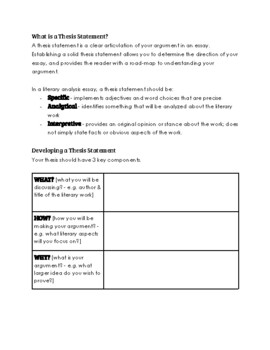
Thesis Statement Workshop - AP Literary Argument Analysis Essay
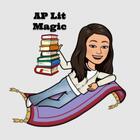
Thesis Statement Literary Analysis Templates Google Classroom FREE
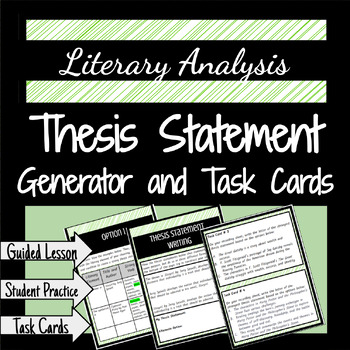
Literary Analysis Thesis Statement : Lesson, Practice, and Task Cards

Thesis Statement Literary Analysis Distance Learning
- Internet Activities
- Easel Activity
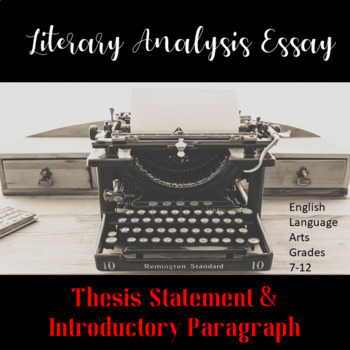
Literary Analysis Essay: Thesis Statement and Introductory Paragraph

Mother to Son Literary Analysis Thesis Statement Creation

- Google Docs™
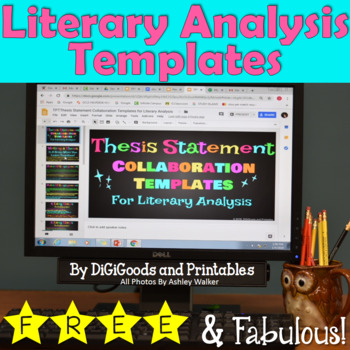
5 Paragraph Literary Analysis Thesis Statement Templates FREE

Thesis Statement Literary Analysis 2 Pronged

Literary Analysis Thesis Statements Lesson Set, Writing Literary Analysis Essays
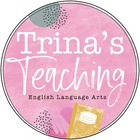
Thesis Statement Literary Analysis Distance Learning Struggling Writers
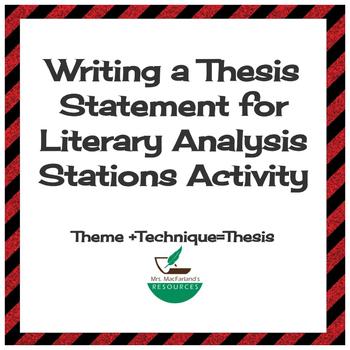
Writing a Thesis Statement for Literary Analysis Station Activity (ONE WORK)
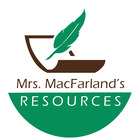
Writing a Thesis Statement for a Literary Analysis Essay

Thank You Ma'am Literary Analysis Thesis Statement Practice

A&P John Updike Thesis Statement & Literary Analysis Practice

Literary Analysis Thesis Statement Planning

Literary Analysis Thesis Statement Creation- The Two Brothers by Leo Tolstoy
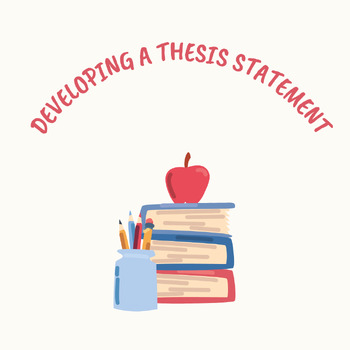
Developing a Thesis Statement for a Literary Analysis

Literary Analysis Thesis Statement and Topic Sentences Check

Literary Analysis Essay Thesis Statement Stems- Use with ANY work of fiction!

- We're hiring
- Help & FAQ
- Privacy policy
- Student privacy
- Terms of service
- Tell us what you think
Literary Essay
Loading ad...
makishapowell
Literary essay
- Google Classroom
- Microsoft Teams
- Download PDF
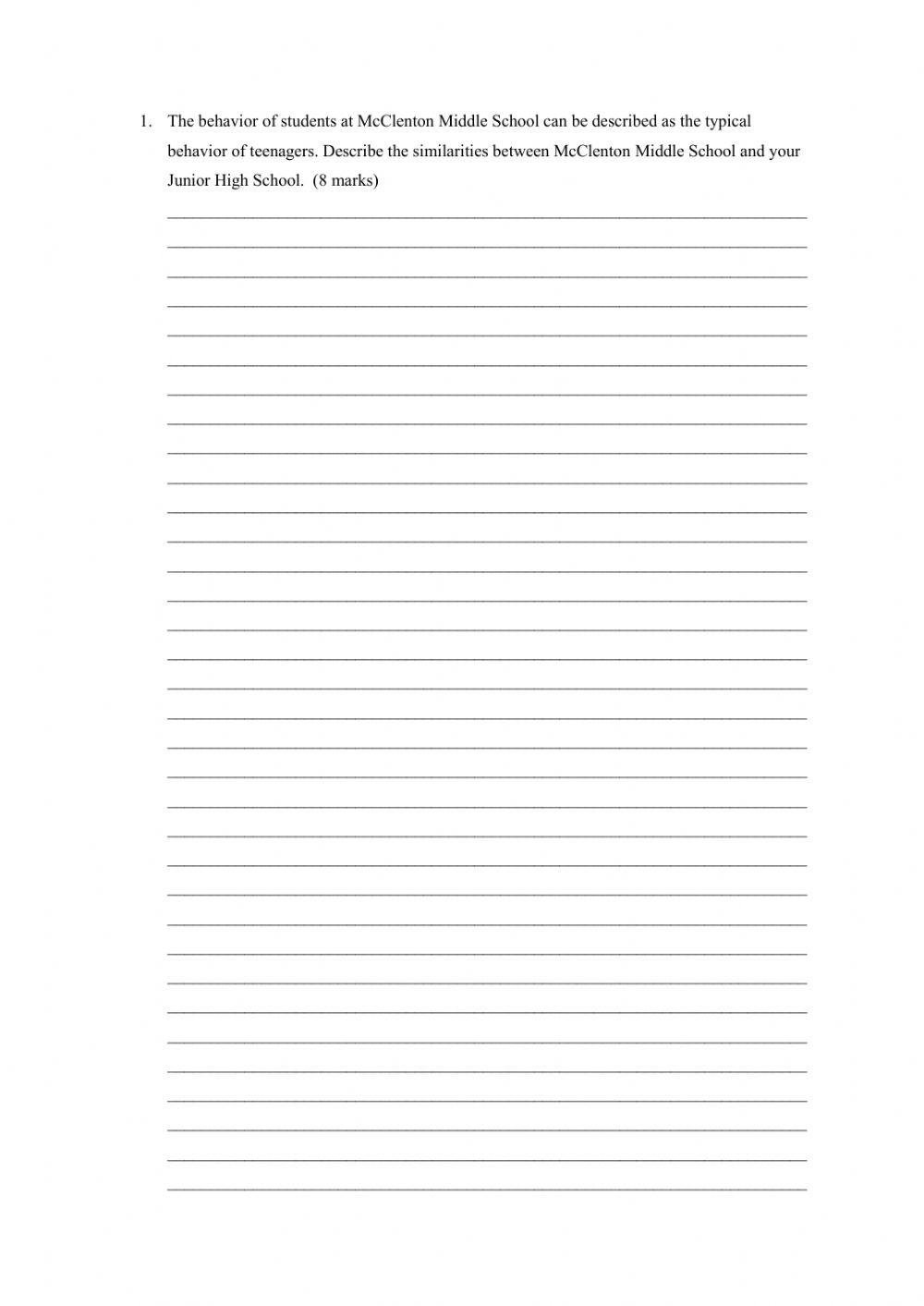

COMMENTS
Included in the activity are. an editable PowerPoint that introduces how to analyze quotes. an Interactive notebook lesson. literary quote analysis homework worksheet that is print and go. and an editable literary quote analysis homework sheet. 2. A moonlighting English teacher - prose analysis and close reading.
Literary analysis is the foundation of high-level English classes—but what, exactly, is literary analysis, and how do you do it? In this article, we'll share how to perform literary analysis on any text, as well as how to write a literary analysis essay (including worksheets for writing your thesis statement and body paragraphs).
Discovering Evidence for a Literary Analysis Essay, Fall 2014. 2 of 6. meaning of a literary work. This handout focuses on how to write an explication essay because explication is the foundation for literary analysis, whether the essay be a critical argument or an explication. Literary analysis begins with a study of form and effect.
2. Graphic Organizers. Graphic organizers are one of my go-to strategies for elevating thinking. We can use them to differentiate and to guide students as we work in small groups. I like to keep a variety of literary analysis graphic organizers for any text on hand so that I can be responsive.
The term regularly used for the development of the central idea of a literary analysis essay is the body. In this section you present the paragraphs (at least 3 paragraphs for a 500-750 word essay) that support your thesis statement. Good literary analysis essays contain an explanation of your ideas and evidence from the text (short story,
Table of contents. Step 1: Reading the text and identifying literary devices. Step 2: Coming up with a thesis. Step 3: Writing a title and introduction. Step 4: Writing the body of the essay. Step 5: Writing a conclusion. Other interesting articles.
The essay may focus on the creator's technical skills, their success in supporting their theme, an analysis of particular elements, or more. Similar to persuasive writing, essays of this sort have a thesis. Each set of worksheets includes definitions, examples, tips, checklists, and writing prompts with topics, so be sure to print all of them.
These literary analysis worksheets prompt your child to take a closer look at the underlying meaning of literary texts and guide him through identifying themes, plot, characters, and other literary devices. Help your kid decode literature with these literary analysis worksheets. Literary analysis worksheets will help your kid take a closer look ...
Plan a literary essay! Challenge your fourth graders to think about character traits and themes in this literary essay graphic organizer. To practice the writing process, students will outline the important parts of any essay—from the hook and thesis to a grand conclusion. This worksheet provides a great starting point for students as they ...
Essays, books, and scripts all have one thing in common—purposeful organization. Literary analysis worksheets show students how to craft the perfect essay, no matter the assignment. With reading activities, writing prompts, graphic organizers, reading logs, and more, students gain skills necessary to succeed in writing.
Our Literary Analysis Essay Unit is designed to guide students through the full process of writing a formal essay from scratch over 3-8 class periods. The longer Literary Analysis Guided Draft essay plan leads students to draft full literary analysis essays over the course of two weeks. Activities include a mix of pre-writing, scaffolded ...
3. Body: The body of your paper should logically and fully develop and support your thesis. a. Each body paragraph should focus on one main idea that supports your thesis statement. b. These paragraphs include: i. A topic sentence - a topic sentence states the main point of a paragraph: it serves as a mini-thesis for the paragraph.
Strong literary essays begin with effective annotating! This bundle includes handouts, graphic organizers, color-coded student essay samples, elaboration practice, and more! From thesis statement to conclusion, this packet makes introducing the literary essay easy!This product is a PDF file and incl
Language: English (en) ID: 694520. 04/02/2021. Country code: BS. Country: Bahamas. School subject: Literature (1061817) Main content: Analysis of a literary text (1267963) The Skin I'm In--Literary analysis of the theme betrayal. Other contents: The Skin I'm In.
Beyond that, there are a few more tricks that one can use to enhance one's skills quickly. These persuasive essay worksheets and activities will help students master these tricks. Creating Persuasive Attention Catchers Activity - Students practice creating persuasive leads that immediately push the reader toward their side of the argument.
Save with a bundle! This comprehensive writing bundle contains FOUR unit plans including a 2-Week Expository Essay Unit, a 2-Week Narrative Writing Unit, a 2.5-Week Persuasive Writing Unit, and a 1-Week Literary Analysis Essay Unit that can be used for any text! All units use the Reader's Writer's W
Thesis Statement Workshop for Literary Analysis EssayThis workshop teaches students to develop a 1-pronged thesis statement for a 3 paragraph essay. Allow your students to learn the same skills, but with a more manageable format. This workshop has been modified for struggling and lower grade writers.
Practice Writing a Strong Lead: Literary Essay. Hook your reader with a great introduction! Strong leading sentences grab the reader's attention and set the tone for an essay. Students will practice writing strong leads for their literary essays as they complete this activity. Download Free Worksheet. Add to collection. Add to assignment.
literary essay: English ESL worksheets pdf & doc. English ESL Worksheets. literary essay.
Literary essay Liveworksheets transforms your traditional printable worksheets into self-correcting interactive exercises that the students can do online and send to the teacher. Literary Essay worksheet | Live Worksheets
Worksheet Crafting a Thesis Statement: Literary Essay Writing. Writing a thesis statement requires practice and revision! This activity will afford your fourth graders the chance to think about the claim they want to make in their literary essays and give them practice writing an introductory paragraph.
After you and your partner have read your essays out loud and discussed them, respond to the following questions. Give this written evaluation to your partner so he/she can take it home and have your comments to reflect on during revision. Your evaluation must be turned in to me with your final essay; it is part of your grade! Introduction: a.
Worksheet. Household Chores: Opinion Writing Exercise. Worksheet. Crafting Imagery. Worksheet. Respond to Art: Opinion & Evidence #2. Worksheet. 1 2. Our fourth grade essay writing worksheets will help students write their own tickets for success with different text types.